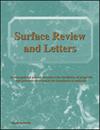Effect of Fe content on the structural and magnetic properties of ternary (Ni60Co40)100-xFex nanomaterials synthesized by hydrothermal route
IF 1.2
4区 材料科学
Q4 CHEMISTRY, PHYSICAL
引用次数: 0
Abstract
The effect of iron content on the structure, morphology and magnetic properties of (Ni[Formula: see text]Co[Formula: see text])[Formula: see text]Fe[Formula: see text] powders synthesized by hydrothermal method has been studied. Several samples have been elaborated for different Fe content ([Formula: see text] = 0, 3, 5, 7, 10 and 13.5). The as- prepared samples have been characterized by X-ray diffraction (XRD), Scanning Electron Microscopy (SEM) and Vibrating Sample Magnetometry (VSM). From XRD spectra and for all Fe content, we have shown the presence of both face centered cubic (FCC) and Hexagonal (HCP) nanosized phases. The lattice parameter increases with increasing Fe content and the grains size varies with Fe content to reach a minimum value of 32 nm for (Co[Formula: see text]Ni[Formula: see text])[Formula: see text]Fe[Formula: see text]. From hysteresis curves, we have extracted the saturation magnetization, Ms, and the coercivity, Hc. We noticed that Ms increases and then decreases as a function of Fe content. The values of Hc vary from 156 Oe to 186 Oe depending on the particles shape.铁含量对水热法合成的100-xFex三元(Ni60Co40)纳米材料结构和磁性能的影响
研究了铁含量对水热法制备的(Ni[公式:见文]Co[公式:见文])Fe[公式:见文]粉末的结构、形貌和磁性能的影响。对不同铁含量的几个样品进行了阐述([公式:见正文]= 0,3,5,7,10和13.5)。用x射线衍射(XRD)、扫描电镜(SEM)和振动样品磁强计(VSM)对制备的样品进行了表征。从XRD光谱和所有Fe含量中,我们都发现了面心立方(FCC)和六方(HCP)纳米相的存在。晶格参数随Fe含量的增加而增加,晶粒尺寸随Fe含量的增加而变化,(Co[公式:见文]]Ni[公式:见文])Fe[公式:见文]的最小值为32 nm。从磁滞曲线中,我们提取了饱和磁化强度Ms和矫顽力Hc。我们注意到Ms随Fe含量的变化先增大后减小。Hc的值根据粒子的形状从156欧欧到186欧欧不等。
本文章由计算机程序翻译,如有差异,请以英文原文为准。
求助全文
约1分钟内获得全文
求助全文
来源期刊

Surface Review and Letters
工程技术-物理:凝聚态物理
CiteScore
2.20
自引率
9.10%
发文量
139
审稿时长
4.2 months
期刊介绍:
This international journal is devoted to the elucidation of properties and processes that occur at the boundaries of materials. The scope of the journal covers a broad range of topics in experimental and theoretical studies of surfaces and interfaces. Both the physical and chemical properties are covered. The journal also places emphasis on emerging areas of cross-disciplinary research where new phenomena occur due to the presence of a surface or an interface. Representative areas include surface and interface structures; their electronic, magnetic and optical properties; dynamics and energetics; chemical reactions at surfaces; phase transitions, reconstruction, roughening and melting; defects, nucleation and growth; and new surface and interface characterization techniques.
 求助内容:
求助内容: 应助结果提醒方式:
应助结果提醒方式:


